2013
Exibindo questões de 1 a 100.
A) longer b) far c) more d) less e) fewer Resolução “… - UNIFESP 2013
Inglês - 2013Work after eight months of pregnancy is as
harmful as smoking, study finds
Conal Urquhart and agencies
July 28, 2012
Working after eight months of pregnancy is as harmful for babies as smoking, according to a new study. Women who worked after they were eight months pregnant had babies on average around 230g lighter than those who stopped work between six and eight months.
The University of Essex research – which drew on data from three major studies, two in the UK and one in the US – found the effect of continuing to work during the late stages of pregnancy was equal to that of smoking while pregnant. Babies whose mothers worked or smoked throughout pregnancy grew more slowly in the womb.
Past research has shown babies with low birth weights are at higher risk of poor health and slow development, and may suffer from a variety of problems later in life. Stopping work early in pregnancy was particularly beneficial for women with lower levels of education, the study found – suggesting that the effect of working during pregnancy was possibly more marked for those doing physically demanding work. The birth weight of babies born to mothers under the age of 24 was not affected by them continuing to work, but in older mothers the effect was more significant.
The researchers identified 1,339 children whose mothers were part of the British Household Panel Survey, which was conducted between 1991 and 2005, and for whom data was available. A further sample of 17,483 women who gave birth in 2000 or 2001 and who took part in the Millennium Cohort Study was also examined and showed similar results, along with 12,166 from the National Survey of Family Growth, relating to births in the US between the early 1970s and 1995.
One of the authors of the study, Prof. Marco Francesconi, said the government should consider incentives employers to offer more flexible maternity leave to 42 women who might need a break before, 43 after, their babies were born. He said: “We know low birth weight is a predictor of many things that happen later, including lower chances of completing school successfully, lower wages and higher mortality. We need to think seriously about parental leave, because – as this study suggests – the possible benefits of taking leave flexibly before the birth 44 quite high.”
The study also suggests British women may be working for 45 now during pregnancy. While 16% of mothers questioned by the British Household Panel Study, which went as far back as 1991, worked up to one month before the birth, the figure was 30% in the Millennium Cohort Study, whose subjects were born in 2000 and 2001
(www.guardian.co.uk)
A) simply aren’t b) could be c) can’t be d) are not - UNIFESP 2013
Inglês - 2013Work after eight months of pregnancy is as
harmful as smoking, study finds
Conal Urquhart and agencies
July 28, 2012
Working after eight months of pregnancy is as harmful for babies as smoking, according to a new study. Women who worked after they were eight months pregnant had babies on average around 230g lighter than those who stopped work between six and eight months.
The University of Essex research – which drew on data from three major studies, two in the UK and one in the US – found the effect of continuing to work during the late stages of pregnancy was equal to that of smoking while pregnant. Babies whose mothers worked or smoked throughout pregnancy grew more slowly in the womb.
Past research has shown babies with low birth weights are at higher risk of poor health and slow development, and may suffer from a variety of problems later in life. Stopping work early in pregnancy was particularly beneficial for women with lower levels of education, the study found – suggesting that the effect of working during pregnancy was possibly more marked for those doing physically demanding work. The birth weight of babies born to mothers under the age of 24 was not affected by them continuing to work, but in older mothers the effect was more significant.
The researchers identified 1,339 children whose mothers were part of the British Household Panel Survey, which was conducted between 1991 and 2005, and for whom data was available. A further sample of 17,483 women who gave birth in 2000 or 2001 and who took part in the Millennium Cohort Study was also examined and showed similar results, along with 12,166 from the National Survey of Family Growth, relating to births in the US between the early 1970s and 1995.
One of the authors of the study, Prof. Marco Francesconi, said the government should consider incentives employers to offer more flexible maternity leave to 42 women who might need a break before, 43 after, their babies were born. He said: “We know low birth weight is a predictor of many things that happen later, including lower chances of completing school successfully, lower wages and higher mortality. We need to think seriously about parental leave, because – as this study suggests – the possible benefits of taking leave flexibly before the birth 44 quite high.”
The study also suggests British women may be working for 45 now during pregnancy. While 16% of mothers questioned by the British Household Panel Study, which went as far back as 1991, worked up to one month before the birth, the figure was 30% in the Millennium Cohort Study, whose subjects were born in 2000 and 2001
(www.guardian.co.uk)
A) rather than b) no c) less likely d) but e) instead - UNIFESP 2013
Língua Portuguesa - 2013Work after eight months of pregnancy is as
harmful as smoking, study finds
Conal Urquhart and agencies
July 28, 2012
Working after eight months of pregnancy is as harmful for babies as smoking, according to a new study. Women who worked after they were eight months pregnant had babies on average around 230g lighter than those who stopped work between six and eight months.
The University of Essex research – which drew on data from three major studies, two in the UK and one in the US – found the effect of continuing to work during the late stages of pregnancy was equal to that of smoking while pregnant. Babies whose mothers worked or smoked throughout pregnancy grew more slowly in the womb.
Past research has shown babies with low birth weights are at higher risk of poor health and slow development, and may suffer from a variety of problems later in life. Stopping work early in pregnancy was particularly beneficial for women with lower levels of education, the study found – suggesting that the effect of working during pregnancy was possibly more marked for those doing physically demanding work. The birth weight of babies born to mothers under the age of 24 was not affected by them continuing to work, but in older mothers the effect was more significant.
The researchers identified 1,339 children whose mothers were part of the British Household Panel Survey, which was conducted between 1991 and 2005, and for whom data was available. A further sample of 17,483 women who gave birth in 2000 or 2001 and who took part in the Millennium Cohort Study was also examined and showed similar results, along with 12,166 from the National Survey of Family Growth, relating to births in the US between the early 1970s and 1995.
One of the authors of the study, Prof. Marco Francesconi, said the government should consider incentives employers to offer more flexible maternity leave to 42 women who might need a break before, 43 after, their babies were born. He said: “We know low birth weight is a predictor of many things that happen later, including lower chances of completing school successfully, lower wages and higher mortality. We need to think seriously about parental leave, because – as this study suggests – the possible benefits of taking leave flexibly before the birth 44 quite high.”
The study also suggests British women may be working for 45 now during pregnancy. While 16% of mothers questioned by the British Household Panel Study, which went as far back as 1991, worked up to one month before the birth, the figure was 30% in the Millennium Cohort Study, whose subjects were born in 2000 and 2001
(www.guardian.co.uk)
A) through b) about c) by d) for e) with Resolução “…th - UNIFESP 2013
Inglês - 2013Work after eight months of pregnancy is as
harmful as smoking, study finds
Conal Urquhart and agencies
July 28, 2012
Working after eight months of pregnancy is as harmful for babies as smoking, according to a new study. Women who worked after they were eight months pregnant had babies on average around 230g lighter than those who stopped work between six and eight months.
The University of Essex research – which drew on data from three major studies, two in the UK and one in the US – found the effect of continuing to work during the late stages of pregnancy was equal to that of smoking while pregnant. Babies whose mothers worked or smoked throughout pregnancy grew more slowly in the womb.
Past research has shown babies with low birth weights are at higher risk of poor health and slow development, and may suffer from a variety of problems later in life. Stopping work early in pregnancy was particularly beneficial for women with lower levels of education, the study found – suggesting that the effect of working during pregnancy was possibly more marked for those doing physically demanding work. The birth weight of babies born to mothers under the age of 24 was not affected by them continuing to work, but in older mothers the effect was more significant.
The researchers identified 1,339 children whose mothers were part of the British Household Panel Survey, which was conducted between 1991 and 2005, and for whom data was available. A further sample of 17,483 women who gave birth in 2000 or 2001 and who took part in the Millennium Cohort Study was also examined and showed similar results, along with 12,166 from the National Survey of Family Growth, relating to births in the US between the early 1970s and 1995.
One of the authors of the study, Prof. Marco Francesconi, said the government should consider incentives employers to offer more flexible maternity leave to 42 women who might need a break before, 43 after, their babies were born. He said: “We know low birth weight is a predictor of many things that happen later, including lower chances of completing school successfully, lower wages and higher mortality. We need to think seriously about parental leave, because – as this study suggests – the possible benefits of taking leave flexibly before the birth 44 quite high.”
The study also suggests British women may be working for 45 now during pregnancy. While 16% of mothers questioned by the British Household Panel Study, which went as far back as 1991, worked up to one month before the birth, the figure was 30% in the Millennium Cohort Study, whose subjects were born in 2000 and 2001
(www.guardian.co.uk)
In the excerpt from the third paragraph – may suffer - UNIFESP 2013
Inglês - 2013Work after eight months of pregnancy is as
harmful as smoking, study finds
Conal Urquhart and agencies
July 28, 2012
Working after eight months of pregnancy is as harmful for babies as smoking, according to a new study. Women who worked after they were eight months pregnant had babies on average around 230g lighter than those who stopped work between six and eight months.
The University of Essex research – which drew on data from three major studies, two in the UK and one in the US – found the effect of continuing to work during the late stages of pregnancy was equal to that of smoking while pregnant. Babies whose mothers worked or smoked throughout pregnancy grew more slowly in the womb.
Past research has shown babies with low birth weights are at higher risk of poor health and slow development, and may suffer from a variety of problems later in life. Stopping work early in pregnancy was particularly beneficial for women with lower levels of education, the study found – suggesting that the effect of working during pregnancy was possibly more marked for those doing physically demanding work. The birth weight of babies born to mothers under the age of 24 was not affected by them continuing to work, but in older mothers the effect was more significant.
The researchers identified 1,339 children whose mothers were part of the British Household Panel Survey, which was conducted between 1991 and 2005, and for whom data was available. A further sample of 17,483 women who gave birth in 2000 or 2001 and who took part in the Millennium Cohort Study was also examined and showed similar results, along with 12,166 from the National Survey of Family Growth, relating to births in the US between the early 1970s and 1995.
One of the authors of the study, Prof. Marco Francesconi, said the government should consider incentives employers to offer more flexible maternity leave to 42 women who might need a break before, 43 after, their babies were born. He said: “We know low birth weight is a predictor of many things that happen later, including lower chances of completing school successfully, lower wages and higher mortality. We need to think seriously about parental leave, because – as this study suggests – the possible benefits of taking leave flexibly before the birth 44 quite high.”
The study also suggests British women may be working for 45 now during pregnancy. While 16% of mothers questioned by the British Household Panel Study, which went as far back as 1991, worked up to one month before the birth, the figure was 30% in the Millennium Cohort Study, whose subjects were born in 2000 and 2001
(www.guardian.co.uk)
In the excerpt from the first paragraph – than those - UNIFESP 2013
Inglês - 2013Work after eight months of pregnancy is as
harmful as smoking, study finds
Conal Urquhart and agencies
July 28, 2012
Working after eight months of pregnancy is as harmful for babies as smoking, according to a new study. Women who worked after they were eight months pregnant had babies on average around 230g lighter than those who stopped work between six and eight months.
The University of Essex research – which drew on data from three major studies, two in the UK and one in the US – found the effect of continuing to work during the late stages of pregnancy was equal to that of smoking while pregnant. Babies whose mothers worked or smoked throughout pregnancy grew more slowly in the womb.
Past research has shown babies with low birth weights are at higher risk of poor health and slow development, and may suffer from a variety of problems later in life. Stopping work early in pregnancy was particularly beneficial for women with lower levels of education, the study found – suggesting that the effect of working during pregnancy was possibly more marked for those doing physically demanding work. The birth weight of babies born to mothers under the age of 24 was not affected by them continuing to work, but in older mothers the effect was more significant.
The researchers identified 1,339 children whose mothers were part of the British Household Panel Survey, which was conducted between 1991 and 2005, and for whom data was available. A further sample of 17,483 women who gave birth in 2000 or 2001 and who took part in the Millennium Cohort Study was also examined and showed similar results, along with 12,166 from the National Survey of Family Growth, relating to births in the US between the early 1970s and 1995.
One of the authors of the study, Prof. Marco Francesconi, said the government should consider incentives employers to offer more flexible maternity leave to 42 women who might need a break before, 43 after, their babies were born. He said: “We know low birth weight is a predictor of many things that happen later, including lower chances of completing school successfully, lower wages and higher mortality. We need to think seriously about parental leave, because – as this study suggests – the possible benefits of taking leave flexibly before the birth 44 quite high.”
The study also suggests British women may be working for 45 now during pregnancy. While 16% of mothers questioned by the British Household Panel Study, which went as far back as 1991, worked up to one month before the birth, the figure was 30% in the Millennium Cohort Study, whose subjects were born in 2000 and 2001
(www.guardian.co.uk)
O estudo mencionado no texto indica que a) as mulheres - UNIFESP 2013
Inglês - 2013Work after eight months of pregnancy is as
harmful as smoking, study finds
Conal Urquhart and agencies
July 28, 2012
Working after eight months of pregnancy is as harmful for babies as smoking, according to a new study. Women who worked after they were eight months pregnant had babies on average around 230g lighter than those who stopped work between six and eight months.
The University of Essex research – which drew on data from three major studies, two in the UK and one in the US – found the effect of continuing to work during the late stages of pregnancy was equal to that of smoking while pregnant. Babies whose mothers worked or smoked throughout pregnancy grew more slowly in the womb.
Past research has shown babies with low birth weights are at higher risk of poor health and slow development, and may suffer from a variety of problems later in life. Stopping work early in pregnancy was particularly beneficial for women with lower levels of education, the study found – suggesting that the effect of working during pregnancy was possibly more marked for those doing physically demanding work. The birth weight of babies born to mothers under the age of 24 was not affected by them continuing to work, but in older mothers the effect was more significant.
The researchers identified 1,339 children whose mothers were part of the British Household Panel Survey, which was conducted between 1991 and 2005, and for whom data was available. A further sample of 17,483 women who gave birth in 2000 or 2001 and who took part in the Millennium Cohort Study was also examined and showed similar results, along with 12,166 from the National Survey of Family Growth, relating to births in the US between the early 1970s and 1995.
One of the authors of the study, Prof. Marco Francesconi, said the government should consider incentives employers to offer more flexible maternity leave to 42 women who might need a break before, 43 after, their babies were born. He said: “We know low birth weight is a predictor of many things that happen later, including lower chances of completing school successfully, lower wages and higher mortality. We need to think seriously about parental leave, because – as this study suggests – the possible benefits of taking leave flexibly before the birth 44 quite high.”
The study also suggests British women may be working for 45 now during pregnancy. While 16% of mothers questioned by the British Household Panel Study, which went as far back as 1991, worked up to one month before the birth, the figure was 30% in the Millennium Cohort Study, whose subjects were born in 2000 and 2001
(www.guardian.co.uk)
De acordo com a resposta à última pergunta, depreendese - UNIFESP 2013
Inglês - 2013Life of a Nantucket Surgeon
By Tara Parker-Pope
July 27, 2012
In her new book, “Island Practice”, the New York Times reporter Pam Belluck tells the story of Dr. Timothy Lepore, a quirky 67-year-old physician who for the past 30 years has been the only surgeon working on the island of Nantucket. But Dr. Lepore is no ordinary surgeon. Life on an island, even one that has become a summer playground to the rich and famous, requires a certain amount of resourcefulness and flexibility. Over the years Dr. Lepore has taken it upon himself to deliver whatever type of medical care his island inhabitants need, often challenging conventional notions of medicine and redefining what it means to be a healer. While his surgical skills have been used for minor repairs and lifesaving procedures, he often works as a general practitioner, treating everyday ailments. Distraught island residents also call on him for counseling and comfort, and he even steps into the role of veterinarian when needed.
I recently spoke with Ms. Belluck about the time she spent with Dr. Lepore. Here’s part of our conversation.
• I think of Nantucket as a posh summer tourist destination. Were you surprised to find such a quirky character there?
I thought of it as this rich summer haven, but there is this whole year-round population that is really interesting and diverse and has to scrabble for a living. Even the hardship was surprising. You think any place is accessible, but there are a lot of times where you cannot get on or off the island, and you can’t get what you need. Even though they have fast ferries and airplanes now, you’re still at the mercy of the elements, and that creates a lot of drama.
• What kinds of challenges has Dr. Lepore faced?
Part of it is the fact that as the only surgeon, you kind of need to do everything, and you may not know how to do something. There was a guy who came home and had forgotten to pick up potatoes, and his wife stabbed him in the heart. It’s the kind of stab wound that only 10 percent of patients make it to the hospital alive, and 1 percent will survive. Dr. Lepore had never seen anything like this before, but there was no time to get the guy off the island. So he had to reach in and get the heart started. There wasn’t the right equipment to sew him up, and they had only six units of blood, which is not that much. But he’s an encyclopedia of arcane facts, and he remembered that in the 1800s they used black silk thread for this kind of injury. They found some black silk thread, and he managed to close this guy’s heart and get it beating again. The guy survived and became a marathon runner. There is a field hospital-type feeling to it. You’re not under fire, but there is making do with what you have and flying by the seat of your pants. Often the weather is bad, and he has never done it before, but he just has to do it.
• Does he make a good living? Does he take insurance?
He takes insurance, but he also takes people who can’t pay at all. He will even allow people to pay him in kind. One of the undercurrents of the book is that his hospital on Nantucket is now run by Partners Health Care, the big health care corporation that runs Massachusetts General and Brigham and Women’s Hospital. They have instituted some new systems, but he flouts many of them. He says, “Nobody is going to manage my time. Nobody is going to tell me what to do.” They can’t really complain because they need him.
(www.nytimes.com. Adaptado.)
The excerpt from the answer to the second question - UNIFESP 2013
Inglês - 2013Life of a Nantucket Surgeon
By Tara Parker-Pope
July 27, 2012
In her new book, “Island Practice”, the New York Times reporter Pam Belluck tells the story of Dr. Timothy Lepore, a quirky 67-year-old physician who for the past 30 years has been the only surgeon working on the island of Nantucket. But Dr. Lepore is no ordinary surgeon. Life on an island, even one that has become a summer playground to the rich and famous, requires a certain amount of resourcefulness and flexibility. Over the years Dr. Lepore has taken it upon himself to deliver whatever type of medical care his island inhabitants need, often challenging conventional notions of medicine and redefining what it means to be a healer. While his surgical skills have been used for minor repairs and lifesaving procedures, he often works as a general practitioner, treating everyday ailments. Distraught island residents also call on him for counseling and comfort, and he even steps into the role of veterinarian when needed.
I recently spoke with Ms. Belluck about the time she spent with Dr. Lepore. Here’s part of our conversation.
• I think of Nantucket as a posh summer tourist destination. Were you surprised to find such a quirky character there?
I thought of it as this rich summer haven, but there is this whole year-round population that is really interesting and diverse and has to scrabble for a living. Even the hardship was surprising. You think any place is accessible, but there are a lot of times where you cannot get on or off the island, and you can’t get what you need. Even though they have fast ferries and airplanes now, you’re still at the mercy of the elements, and that creates a lot of drama.
• What kinds of challenges has Dr. Lepore faced?
Part of it is the fact that as the only surgeon, you kind of need to do everything, and you may not know how to do something. There was a guy who came home and had forgotten to pick up potatoes, and his wife stabbed him in the heart. It’s the kind of stab wound that only 10 percent of patients make it to the hospital alive, and 1 percent will survive. Dr. Lepore had never seen anything like this before, but there was no time to get the guy off the island. So he had to reach in and get the heart started. There wasn’t the right equipment to sew him up, and they had only six units of blood, which is not that much. But he’s an encyclopedia of arcane facts, and he remembered that in the 1800s they used black silk thread for this kind of injury. They found some black silk thread, and he managed to close this guy’s heart and get it beating again. The guy survived and became a marathon runner. There is a field hospital-type feeling to it. You’re not under fire, but there is making do with what you have and flying by the seat of your pants. Often the weather is bad, and he has never done it before, but he just has to do it.
• Does he make a good living? Does he take insurance?
He takes insurance, but he also takes people who can’t pay at all. He will even allow people to pay him in kind. One of the undercurrents of the book is that his hospital on Nantucket is now run by Partners Health Care, the big health care corporation that runs Massachusetts General and Brigham and Women’s Hospital. They have instituted some new systems, but he flouts many of them. He says, “Nobody is going to manage my time. Nobody is going to tell me what to do.” They can’t really complain because they need him.
(www.nytimes.com. Adaptado.)
Na resposta à segunda pergunta, a autora utiliza a - UNIFESP 2013
Inglês - 2013Life of a Nantucket Surgeon
By Tara Parker-Pope
July 27, 2012
In her new book, “Island Practice”, the New York Times reporter Pam Belluck tells the story of Dr. Timothy Lepore, a quirky 67-year-old physician who for the past 30 years has been the only surgeon working on the island of Nantucket. But Dr. Lepore is no ordinary surgeon. Life on an island, even one that has become a summer playground to the rich and famous, requires a certain amount of resourcefulness and flexibility. Over the years Dr. Lepore has taken it upon himself to deliver whatever type of medical care his island inhabitants need, often challenging conventional notions of medicine and redefining what it means to be a healer. While his surgical skills have been used for minor repairs and lifesaving procedures, he often works as a general practitioner, treating everyday ailments. Distraught island residents also call on him for counseling and comfort, and he even steps into the role of veterinarian when needed.
I recently spoke with Ms. Belluck about the time she spent with Dr. Lepore. Here’s part of our conversation.
• I think of Nantucket as a posh summer tourist destination. Were you surprised to find such a quirky character there?
I thought of it as this rich summer haven, but there is this whole year-round population that is really interesting and diverse and has to scrabble for a living. Even the hardship was surprising. You think any place is accessible, but there are a lot of times where you cannot get on or off the island, and you can’t get what you need. Even though they have fast ferries and airplanes now, you’re still at the mercy of the elements, and that creates a lot of drama.
• What kinds of challenges has Dr. Lepore faced?
Part of it is the fact that as the only surgeon, you kind of need to do everything, and you may not know how to do something. There was a guy who came home and had forgotten to pick up potatoes, and his wife stabbed him in the heart. It’s the kind of stab wound that only 10 percent of patients make it to the hospital alive, and 1 percent will survive. Dr. Lepore had never seen anything like this before, but there was no time to get the guy off the island. So he had to reach in and get the heart started. There wasn’t the right equipment to sew him up, and they had only six units of blood, which is not that much. But he’s an encyclopedia of arcane facts, and he remembered that in the 1800s they used black silk thread for this kind of injury. They found some black silk thread, and he managed to close this guy’s heart and get it beating again. The guy survived and became a marathon runner. There is a field hospital-type feeling to it. You’re not under fire, but there is making do with what you have and flying by the seat of your pants. Often the weather is bad, and he has never done it before, but he just has to do it.
• Does he make a good living? Does he take insurance?
He takes insurance, but he also takes people who can’t pay at all. He will even allow people to pay him in kind. One of the undercurrents of the book is that his hospital on Nantucket is now run by Partners Health Care, the big health care corporation that runs Massachusetts General and Brigham and Women’s Hospital. They have instituted some new systems, but he flouts many of them. He says, “Nobody is going to manage my time. Nobody is going to tell me what to do.” They can’t really complain because they need him.
(www.nytimes.com. Adaptado.)
No trecho da resposta à primeira pergunta – Even - UNIFESP 2013
Língua Portuguesa - 2013Life of a Nantucket Surgeon
By Tara Parker-Pope
July 27, 2012
In her new book, “Island Practice”, the New York Times reporter Pam Belluck tells the story of Dr. Timothy Lepore, a quirky 67-year-old physician who for the past 30 years has been the only surgeon working on the island of Nantucket. But Dr. Lepore is no ordinary surgeon. Life on an island, even one that has become a summer playground to the rich and famous, requires a certain amount of resourcefulness and flexibility. Over the years Dr. Lepore has taken it upon himself to deliver whatever type of medical care his island inhabitants need, often challenging conventional notions of medicine and redefining what it means to be a healer. While his surgical skills have been used for minor repairs and lifesaving procedures, he often works as a general practitioner, treating everyday ailments. Distraught island residents also call on him for counseling and comfort, and he even steps into the role of veterinarian when needed.
I recently spoke with Ms. Belluck about the time she spent with Dr. Lepore. Here’s part of our conversation.
• I think of Nantucket as a posh summer tourist destination. Were you surprised to find such a quirky character there?
I thought of it as this rich summer haven, but there is this whole year-round population that is really interesting and diverse and has to scrabble for a living. Even the hardship was surprising. You think any place is accessible, but there are a lot of times where you cannot get on or off the island, and you can’t get what you need. Even though they have fast ferries and airplanes now, you’re still at the mercy of the elements, and that creates a lot of drama.
• What kinds of challenges has Dr. Lepore faced?
Part of it is the fact that as the only surgeon, you kind of need to do everything, and you may not know how to do something. There was a guy who came home and had forgotten to pick up potatoes, and his wife stabbed him in the heart. It’s the kind of stab wound that only 10 percent of patients make it to the hospital alive, and 1 percent will survive. Dr. Lepore had never seen anything like this before, but there was no time to get the guy off the island. So he had to reach in and get the heart started. There wasn’t the right equipment to sew him up, and they had only six units of blood, which is not that much. But he’s an encyclopedia of arcane facts, and he remembered that in the 1800s they used black silk thread for this kind of injury. They found some black silk thread, and he managed to close this guy’s heart and get it beating again. The guy survived and became a marathon runner. There is a field hospital-type feeling to it. You’re not under fire, but there is making do with what you have and flying by the seat of your pants. Often the weather is bad, and he has never done it before, but he just has to do it.
• Does he make a good living? Does he take insurance?
He takes insurance, but he also takes people who can’t pay at all. He will even allow people to pay him in kind. One of the undercurrents of the book is that his hospital on Nantucket is now run by Partners Health Care, the big health care corporation that runs Massachusetts General and Brigham and Women’s Hospital. They have instituted some new systems, but he flouts many of them. He says, “Nobody is going to manage my time. Nobody is going to tell me what to do.” They can’t really complain because they need him.
(www.nytimes.com. Adaptado.)
The answer to the first question points out that a) - UNIFESP 2013
Língua Portuguesa - 2013Life of a Nantucket Surgeon
By Tara Parker-Pope
July 27, 2012
In her new book, “Island Practice”, the New York Times reporter Pam Belluck tells the story of Dr. Timothy Lepore, a quirky 67-year-old physician who for the past 30 years has been the only surgeon working on the island of Nantucket. But Dr. Lepore is no ordinary surgeon. Life on an island, even one that has become a summer playground to the rich and famous, requires a certain amount of resourcefulness and flexibility. Over the years Dr. Lepore has taken it upon himself to deliver whatever type of medical care his island inhabitants need, often challenging conventional notions of medicine and redefining what it means to be a healer. While his surgical skills have been used for minor repairs and lifesaving procedures, he often works as a general practitioner, treating everyday ailments. Distraught island residents also call on him for counseling and comfort, and he even steps into the role of veterinarian when needed.
I recently spoke with Ms. Belluck about the time she spent with Dr. Lepore. Here’s part of our conversation.
• I think of Nantucket as a posh summer tourist destination. Were you surprised to find such a quirky character there?
I thought of it as this rich summer haven, but there is this whole year-round population that is really interesting and diverse and has to scrabble for a living. Even the hardship was surprising. You think any place is accessible, but there are a lot of times where you cannot get on or off the island, and you can’t get what you need. Even though they have fast ferries and airplanes now, you’re still at the mercy of the elements, and that creates a lot of drama.
• What kinds of challenges has Dr. Lepore faced?
Part of it is the fact that as the only surgeon, you kind of need to do everything, and you may not know how to do something. There was a guy who came home and had forgotten to pick up potatoes, and his wife stabbed him in the heart. It’s the kind of stab wound that only 10 percent of patients make it to the hospital alive, and 1 percent will survive. Dr. Lepore had never seen anything like this before, but there was no time to get the guy off the island. So he had to reach in and get the heart started. There wasn’t the right equipment to sew him up, and they had only six units of blood, which is not that much. But he’s an encyclopedia of arcane facts, and he remembered that in the 1800s they used black silk thread for this kind of injury. They found some black silk thread, and he managed to close this guy’s heart and get it beating again. The guy survived and became a marathon runner. There is a field hospital-type feeling to it. You’re not under fire, but there is making do with what you have and flying by the seat of your pants. Often the weather is bad, and he has never done it before, but he just has to do it.
• Does he make a good living? Does he take insurance?
He takes insurance, but he also takes people who can’t pay at all. He will even allow people to pay him in kind. One of the undercurrents of the book is that his hospital on Nantucket is now run by Partners Health Care, the big health care corporation that runs Massachusetts General and Brigham and Women’s Hospital. They have instituted some new systems, but he flouts many of them. He says, “Nobody is going to manage my time. Nobody is going to tell me what to do.” They can’t really complain because they need him.
(www.nytimes.com. Adaptado.)
No excerto do primeiro parágrafo – Dr. Lepore has - UNIFESP 2013
Literatura - 2013Life of a Nantucket Surgeon
By Tara Parker-Pope
July 27, 2012
In her new book, “Island Practice”, the New York Times reporter Pam Belluck tells the story of Dr. Timothy Lepore, a quirky 67-year-old physician who for the past 30 years has been the only surgeon working on the island of Nantucket. But Dr. Lepore is no ordinary surgeon. Life on an island, even one that has become a summer playground to the rich and famous, requires a certain amount of resourcefulness and flexibility. Over the years Dr. Lepore has taken it upon himself to deliver whatever type of medical care his island inhabitants need, often challenging conventional notions of medicine and redefining what it means to be a healer. While his surgical skills have been used for minor repairs and lifesaving procedures, he often works as a general practitioner, treating everyday ailments. Distraught island residents also call on him for counseling and comfort, and he even steps into the role of veterinarian when needed.
I recently spoke with Ms. Belluck about the time she spent with Dr. Lepore. Here’s part of our conversation.
• I think of Nantucket as a posh summer tourist destination. Were you surprised to find such a quirky character there?
I thought of it as this rich summer haven, but there is this whole year-round population that is really interesting and diverse and has to scrabble for a living. Even the hardship was surprising. You think any place is accessible, but there are a lot of times where you cannot get on or off the island, and you can’t get what you need. Even though they have fast ferries and airplanes now, you’re still at the mercy of the elements, and that creates a lot of drama.
• What kinds of challenges has Dr. Lepore faced?
Part of it is the fact that as the only surgeon, you kind of need to do everything, and you may not know how to do something. There was a guy who came home and had forgotten to pick up potatoes, and his wife stabbed him in the heart. It’s the kind of stab wound that only 10 percent of patients make it to the hospital alive, and 1 percent will survive. Dr. Lepore had never seen anything like this before, but there was no time to get the guy off the island. So he had to reach in and get the heart started. There wasn’t the right equipment to sew him up, and they had only six units of blood, which is not that much. But he’s an encyclopedia of arcane facts, and he remembered that in the 1800s they used black silk thread for this kind of injury. They found some black silk thread, and he managed to close this guy’s heart and get it beating again. The guy survived and became a marathon runner. There is a field hospital-type feeling to it. You’re not under fire, but there is making do with what you have and flying by the seat of your pants. Often the weather is bad, and he has never done it before, but he just has to do it.
• Does he make a good living? Does he take insurance?
He takes insurance, but he also takes people who can’t pay at all. He will even allow people to pay him in kind. One of the undercurrents of the book is that his hospital on Nantucket is now run by Partners Health Care, the big health care corporation that runs Massachusetts General and Brigham and Women’s Hospital. They have instituted some new systems, but he flouts many of them. He says, “Nobody is going to manage my time. Nobody is going to tell me what to do.” They can’t really complain because they need him.
(www.nytimes.com. Adaptado.)
An appropriate expression to describe Dr. Timothy - UNIFESP 2013
Língua Portuguesa - 2013Life of a Nantucket Surgeon
By Tara Parker-Pope
July 27, 2012
In her new book, “Island Practice”, the New York Times reporter Pam Belluck tells the story of Dr. Timothy Lepore, a quirky 67-year-old physician who for the past 30 years has been the only surgeon working on the island of Nantucket. But Dr. Lepore is no ordinary surgeon. Life on an island, even one that has become a summer playground to the rich and famous, requires a certain amount of resourcefulness and flexibility. Over the years Dr. Lepore has taken it upon himself to deliver whatever type of medical care his island inhabitants need, often challenging conventional notions of medicine and redefining what it means to be a healer. While his surgical skills have been used for minor repairs and lifesaving procedures, he often works as a general practitioner, treating everyday ailments. Distraught island residents also call on him for counseling and comfort, and he even steps into the role of veterinarian when needed.
I recently spoke with Ms. Belluck about the time she spent with Dr. Lepore. Here’s part of our conversation.
• I think of Nantucket as a posh summer tourist destination. Were you surprised to find such a quirky character there?
I thought of it as this rich summer haven, but there is this whole year-round population that is really interesting and diverse and has to scrabble for a living. Even the hardship was surprising. You think any place is accessible, but there are a lot of times where you cannot get on or off the island, and you can’t get what you need. Even though they have fast ferries and airplanes now, you’re still at the mercy of the elements, and that creates a lot of drama.
• What kinds of challenges has Dr. Lepore faced?
Part of it is the fact that as the only surgeon, you kind of need to do everything, and you may not know how to do something. There was a guy who came home and had forgotten to pick up potatoes, and his wife stabbed him in the heart. It’s the kind of stab wound that only 10 percent of patients make it to the hospital alive, and 1 percent will survive. Dr. Lepore had never seen anything like this before, but there was no time to get the guy off the island. So he had to reach in and get the heart started. There wasn’t the right equipment to sew him up, and they had only six units of blood, which is not that much. But he’s an encyclopedia of arcane facts, and he remembered that in the 1800s they used black silk thread for this kind of injury. They found some black silk thread, and he managed to close this guy’s heart and get it beating again. The guy survived and became a marathon runner. There is a field hospital-type feeling to it. You’re not under fire, but there is making do with what you have and flying by the seat of your pants. Often the weather is bad, and he has never done it before, but he just has to do it.
• Does he make a good living? Does he take insurance?
He takes insurance, but he also takes people who can’t pay at all. He will even allow people to pay him in kind. One of the undercurrents of the book is that his hospital on Nantucket is now run by Partners Health Care, the big health care corporation that runs Massachusetts General and Brigham and Women’s Hospital. They have instituted some new systems, but he flouts many of them. He says, “Nobody is going to manage my time. Nobody is going to tell me what to do.” They can’t really complain because they need him.
(www.nytimes.com. Adaptado.)
O primeiro parágrafo indica que a ilha de Nantucket a) - UNIFESP 2013
Língua Portuguesa - 2013Life of a Nantucket Surgeon
By Tara Parker-Pope
July 27, 2012
In her new book, “Island Practice”, the New York Times reporter Pam Belluck tells the story of Dr. Timothy Lepore, a quirky 67-year-old physician who for the past 30 years has been the only surgeon working on the island of Nantucket. But Dr. Lepore is no ordinary surgeon. Life on an island, even one that has become a summer playground to the rich and famous, requires a certain amount of resourcefulness and flexibility. Over the years Dr. Lepore has taken it upon himself to deliver whatever type of medical care his island inhabitants need, often challenging conventional notions of medicine and redefining what it means to be a healer. While his surgical skills have been used for minor repairs and lifesaving procedures, he often works as a general practitioner, treating everyday ailments. Distraught island residents also call on him for counseling and comfort, and he even steps into the role of veterinarian when needed.
I recently spoke with Ms. Belluck about the time she spent with Dr. Lepore. Here’s part of our conversation.
• I think of Nantucket as a posh summer tourist destination. Were you surprised to find such a quirky character there?
I thought of it as this rich summer haven, but there is this whole year-round population that is really interesting and diverse and has to scrabble for a living. Even the hardship was surprising. You think any place is accessible, but there are a lot of times where you cannot get on or off the island, and you can’t get what you need. Even though they have fast ferries and airplanes now, you’re still at the mercy of the elements, and that creates a lot of drama.
• What kinds of challenges has Dr. Lepore faced?
Part of it is the fact that as the only surgeon, you kind of need to do everything, and you may not know how to do something. There was a guy who came home and had forgotten to pick up potatoes, and his wife stabbed him in the heart. It’s the kind of stab wound that only 10 percent of patients make it to the hospital alive, and 1 percent will survive. Dr. Lepore had never seen anything like this before, but there was no time to get the guy off the island. So he had to reach in and get the heart started. There wasn’t the right equipment to sew him up, and they had only six units of blood, which is not that much. But he’s an encyclopedia of arcane facts, and he remembered that in the 1800s they used black silk thread for this kind of injury. They found some black silk thread, and he managed to close this guy’s heart and get it beating again. The guy survived and became a marathon runner. There is a field hospital-type feeling to it. You’re not under fire, but there is making do with what you have and flying by the seat of your pants. Often the weather is bad, and he has never done it before, but he just has to do it.
• Does he make a good living? Does he take insurance?
He takes insurance, but he also takes people who can’t pay at all. He will even allow people to pay him in kind. One of the undercurrents of the book is that his hospital on Nantucket is now run by Partners Health Care, the big health care corporation that runs Massachusetts General and Brigham and Women’s Hospital. They have instituted some new systems, but he flouts many of them. He says, “Nobody is going to manage my time. Nobody is going to tell me what to do.” They can’t really complain because they need him.
(www.nytimes.com. Adaptado.)
O efeito de humor da tira advém, dentre outros fatores - UNIFESP 2013
Língua Portuguesa - 2013
No plano formal, o poema é marcado por a) versos branco - UNIFESP 2013
Língua Portuguesa - 2013Apóstrofe à carne
Quando eu pego nas carnes do meu rosto,
Pressinto o fim da orgânica batalha:
– Olhos que o húmus necrófago estraçalha,
Diafragmas, decompondo-se, ao sol-posto.
E o Homem – negro e heteróclito composto,
Onde a alva flama psíquica trabalha,
Desagrega-se e deixa na mortalha
O tacto, a vista, o ouvido, o olfato e o gosto!
Carne, feixe de mônadas bastardas,
Conquanto em flâmeo fogo efêmero ardas,
A dardejar relampejantes brilhos,
Dói-me ver, muito embora a alma te acenda,
Em tua podridão a herança horrenda,
Que eu tenho de deixar para os meus filhos!
(Augusto dos Anjos. Obra completa, 1994.)
No soneto de Augusto dos Anjos, é evidente a) a visão - UNIFESP 2013
Língua Portuguesa - 2013Apóstrofe à carne
Quando eu pego nas carnes do meu rosto,
Pressinto o fim da orgânica batalha:
– Olhos que o húmus necrófago estraçalha,
Diafragmas, decompondo-se, ao sol-posto.
E o Homem – negro e heteróclito composto,
Onde a alva flama psíquica trabalha,
Desagrega-se e deixa na mortalha
O tacto, a vista, o ouvido, o olfato e o gosto!
Carne, feixe de mônadas bastardas,
Conquanto em flâmeo fogo efêmero ardas,
A dardejar relampejantes brilhos,
Dói-me ver, muito embora a alma te acenda,
Em tua podridão a herança horrenda,
Que eu tenho de deixar para os meus filhos!
(Augusto dos Anjos. Obra completa, 1994.)
De acordo com o texto, a ordem estrutural diz respeito - UNIFESP 2013
Língua Portuguesa - 2013Há cerca de dois meses, a jornalista britânica Rowenna Davis, 25 anos, foi furtada. Só que não levaram sua carteira ou seu carro, mas sua identidade virtual. Um hacker invadiu e tomou conta de seu e-mail e – além de bisbilhotar suas mensagens e ter acesso a seus dados bancários – passou a escrever aos mais de 5 mil contatos de Rowenna dizendo que ela teria sido assaltada em Madri e pedindo ajuda em dinheiro.
Quando ela escreveu para seu endereço de e-mail pedindo ao hacker ao menos sua lista de contatos profissionais de volta, Rowenna teve como resposta a cobrança de R$ 1,4 mil. Ela se negou a pagar, a polícia não fez nada. A jornalista só retomou o controle do email porque um amigo conhecia um funcionário do provedor da conta, que desativou o processo de verificação de senha criado pelo invasor.
(Galileu, dezembro de 2011. Adaptado.)
Considere as seguintes passagens do texto: — [...] é - UNIFESP 2013
Língua Portuguesa - 2013Há cerca de dois meses, a jornalista britânica Rowenna Davis, 25 anos, foi furtada. Só que não levaram sua carteira ou seu carro, mas sua identidade virtual. Um hacker invadiu e tomou conta de seu e-mail e – além de bisbilhotar suas mensagens e ter acesso a seus dados bancários – passou a escrever aos mais de 5 mil contatos de Rowenna dizendo que ela teria sido assaltada em Madri e pedindo ajuda em dinheiro.
Quando ela escreveu para seu endereço de e-mail pedindo ao hacker ao menos sua lista de contatos profissionais de volta, Rowenna teve como resposta a cobrança de R$ 1,4 mil. Ela se negou a pagar, a polícia não fez nada. A jornalista só retomou o controle do email porque um amigo conhecia um funcionário do provedor da conta, que desativou o processo de verificação de senha criado pelo invasor.
(Galileu, dezembro de 2011. Adaptado.)
Assinale a alternativa que traz uma explicação - UNIFESP 2013
Língua Portuguesa - 2013Há cerca de dois meses, a jornalista britânica Rowenna Davis, 25 anos, foi furtada. Só que não levaram sua carteira ou seu carro, mas sua identidade virtual. Um hacker invadiu e tomou conta de seu e-mail e – além de bisbilhotar suas mensagens e ter acesso a seus dados bancários – passou a escrever aos mais de 5 mil contatos de Rowenna dizendo que ela teria sido assaltada em Madri e pedindo ajuda em dinheiro.
Quando ela escreveu para seu endereço de e-mail pedindo ao hacker ao menos sua lista de contatos profissionais de volta, Rowenna teve como resposta a cobrança de R$ 1,4 mil. Ela se negou a pagar, a polícia não fez nada. A jornalista só retomou o controle do email porque um amigo conhecia um funcionário do provedor da conta, que desativou o processo de verificação de senha criado pelo invasor.
(Galileu, dezembro de 2011. Adaptado.)
Assinale a alternativa em que, na reescrita do trecho, - UNIFESP 2013
Língua Portuguesa - 2013Há cerca de dois meses, a jornalista britânica Rowenna Davis, 25 anos, foi furtada. Só que não levaram sua carteira ou seu carro, mas sua identidade virtual. Um hacker invadiu e tomou conta de seu e-mail e – além de bisbilhotar suas mensagens e ter acesso a seus dados bancários – passou a escrever aos mais de 5 mil contatos de Rowenna dizendo que ela teria sido assaltada em Madri e pedindo ajuda em dinheiro.
Quando ela escreveu para seu endereço de e-mail pedindo ao hacker ao menos sua lista de contatos profissionais de volta, Rowenna teve como resposta a cobrança de R$ 1,4 mil. Ela se negou a pagar, a polícia não fez nada. A jornalista só retomou o controle do email porque um amigo conhecia um funcionário do provedor da conta, que desativou o processo de verificação de senha criado pelo invasor.
(Galileu, dezembro de 2011. Adaptado.)
As informações do segundo parágrafo permitem concluir - UNIFESP 2013
Língua Portuguesa - 2013Há cerca de dois meses, a jornalista britânica Rowenna Davis, 25 anos, foi furtada. Só que não levaram sua carteira ou seu carro, mas sua identidade virtual. Um hacker invadiu e tomou conta de seu e-mail e – além de bisbilhotar suas mensagens e ter acesso a seus dados bancários – passou a escrever aos mais de 5 mil contatos de Rowenna dizendo que ela teria sido assaltada em Madri e pedindo ajuda em dinheiro.
Quando ela escreveu para seu endereço de e-mail pedindo ao hacker ao menos sua lista de contatos profissionais de volta, Rowenna teve como resposta a cobrança de R$ 1,4 mil. Ela se negou a pagar, a polícia não fez nada. A jornalista só retomou o controle do email porque um amigo conhecia um funcionário do provedor da conta, que desativou o processo de verificação de senha criado pelo invasor.
(Galileu, dezembro de 2011. Adaptado.)
A lacuna do início do texto deve ser corretamente - UNIFESP 2013
Língua Portuguesa - 2013______________ dois meses, a jornalista britânica Rowenna Davis, 25 anos, foi furtada. Só que não levaram sua carteira ou seu carro, mas sua identidade virtual. Um hacker invadiu e tomou conta de seu e-mail e – além de bisbilhotar suas mensagens e ter acesso a seus dados bancários – passou a escrever aos mais de 5 mil contatos de Rowenna dizendo que ela teria sido assaltada em Madri e pedindo ajuda em dinheiro.
Quando ela escreveu para seu endereço de e-mail pedindo ao hacker ao menos sua lista de contatos profissionais de volta, Rowenna teve como resposta a cobrança de R$ 1,4 mil. Ela se negou a pagar, a polícia não fez nada. A jornalista só retomou o controle do email porque um amigo conhecia um funcionário do provedor da conta, que desativou o processo de verificação de senha criado pelo invasor.
(Galileu, dezembro de 2011. Adaptado.)
Leia o poema “Prece”, de Fernando Pessoa. Senhor, a - UNIFESP 2013
Língua Portuguesa - 2013Leia o poema “Prece”, de Fernando Pessoa.
Senhor, a noite veio e a alma é vil.
Tanta foi a tormenta e a vontade!
Restam-nos hoje, no silêncio hostil,
O mar universal e a saudade.
Mas a chama, que a vida em nós criou,
Se ainda há vida ainda não é finda.
O frio morto em cinzas a ocultou:
A mão do vento pode erguê-la ainda.
Dá o sopro, a aragem – ou desgraça ou ânsia –,
Com que a chama do esforço se remoça,
E outra vez conquistaremos a Distância –
Do mar ou outra, mas que seja nossa!
Bastante comum na fala coloquial, o modo de se - UNIFESP 2013
Língua Portuguesa - 2013
O Hatha yoga pradipika, sagrada escritura do hatha yoga - UNIFESP 2013
Língua Portuguesa - 2013O Hatha yoga pradipika, sagrada escritura do hatha yoga, escrita no século 15 da era atual, diz que, antes de nos aventurarmos na prática de austeridade e códigos morais, devemos nos preparar. Autocontrole e disciplina sem preparação adequada ______________ criar mais problemas mentais e de personalidade do que paz de espírito. A beleza dessa escritura é que ela resolve o grande problema que todo iniciante enfrenta: dominar a mente.
Devido _____________ abordagem corporal, o hatha yoga ficou conhecido – de modo equivocado – como uma categoria de ioga _______________ trabalha apenas as valências físicas (força, flexibilidade, resistência, equilíbrio e outras), quase como ginástica oriental. Isso não é verdade.
Assinale a alternativa em que a eliminação do pronome - UNIFESP 2013
Língua Portuguesa - 2013Um sarau é o bocado mais delicioso que temos, de telhado abaixo. Em um sarau todo o mundo tem que fazer. O diplomata ajusta, com um copo de champagne na mão, os mais intrincados negócios; todos murmuram, e não há quem deixe de ser murmurado. O velho lembra-se dos minuetes e das cantigas do seu tempo, e o moço goza todos os regalos da sua época; as moças são no sarau como as estrelas no céu; estão no seu elemento: aqui uma, cantando suave cavatina, eleva-se vaidosa nas asas dos aplausos, por entre os quais surde, às vezes, um bravíssimo inopinado, que solta de lá da sala do jogo o parceiro que acaba de ganhar sua partida no écarté, mesmo na ocasião em que a moça se espicha completamente, desafinando um sustenido; daí a pouco vão outras, pelos braços de seus pares, se deslizando pela sala e marchando em seu passeio, mais a compasso que qualquer de nossos batalhões da Guarda Nacional, ao mesmo tempo que conversam sempre sobre objetos inocentes que movem olhaduras e risadinhas apreciáveis. Outras criticam de uma gorducha vovó, que ensaca nos bolsos meia bandeja de doces que veio para o chá, e que ela leva aos pequenos que, diz, lhe ficaram em casa. Ali vê-se um ataviado dandy que dirige mil finezas a uma senhora idosa, tendo os olhos pregados na sinhá, que senta-se ao lado. Finalmente, no sarau não é essencial ter cabeça nem boca, porque, para alguns é regra, durante ele, pensar pelos pés e falar pelos olhos.
E o mais é que nós estamos num sarau. Inúmeros batéis conduziram da corte para a ilha de... senhoras e senhores, recomendáveis por caráter e qualidades; alegre, numerosa e escolhida sociedade enche a grande casa, que brilha e mostra em toda a parte borbulhar o prazer e o bom gosto.
Entre todas essas elegantes e agradáveis moças, que com aturado empenho se esforçam para ver qual delas vence em graças, encantos e donaires, certo sobrepuja a travessa Moreninha, princesa daquela festa.
(Joaquim Manuel de Macedo. A Moreninha, 1997.)
Considerando os papéis desempenhados pelas persona - UNIFESP 2013
Língua Portuguesa - 2013Um sarau é o bocado mais delicioso que temos, de telhado abaixo. Em um sarau todo o mundo tem que fazer. O diplomata ajusta, com um copo de champagne na mão, os mais intrincados negócios; todos murmuram, e não há quem deixe de ser murmurado. O velho lembra-se dos minuetes e das cantigas do seu tempo, e o moço goza todos os regalos da sua época; as moças são no sarau como as estrelas no céu; estão no seu elemento: aqui uma, cantando suave cavatina, eleva-se vaidosa nas asas dos aplausos, por entre os quais surde, às vezes, um bravíssimo inopinado, que solta de lá da sala do jogo o parceiro que acaba de ganhar sua partida no écarté, mesmo na ocasião em que a moça se espicha completamente, desafinando um sustenido; daí a pouco vão outras, pelos braços de seus pares, se deslizando pela sala e marchando em seu passeio, mais a compasso que qualquer de nossos batalhões da Guarda Nacional, ao mesmo tempo que conversam sempre sobre objetos inocentes que movem olhaduras e risadinhas apreciáveis. Outras criticam de uma gorducha vovó, que ensaca nos bolsos meia bandeja de doces que veio para o chá, e que ela leva aos pequenos que, diz, lhe ficaram em casa. Ali vê-se um ataviado dandy que dirige mil finezas a uma senhora idosa, tendo os olhos pregados na sinhá, que senta-se ao lado. Finalmente, no sarau não é essencial ter cabeça nem boca, porque, para alguns é regra, durante ele, pensar pelos pés e falar pelos olhos.
E o mais é que nós estamos num sarau. Inúmeros batéis conduziram da corte para a ilha de... senhoras e senhores, recomendáveis por caráter e qualidades; alegre, numerosa e escolhida sociedade enche a grande casa, que brilha e mostra em toda a parte borbulhar o prazer e o bom gosto.
Entre todas essas elegantes e agradáveis moças, que com aturado empenho se esforçam para ver qual delas vence em graças, encantos e donaires, certo sobrepuja a travessa Moreninha, princesa daquela festa.
(Joaquim Manuel de Macedo. A Moreninha, 1997.)
Levando em conta o contexto em que floresceu a - UNIFESP 2013
Literatura - 2013Um sarau é o bocado mais delicioso que temos, de telhado abaixo. Em um sarau todo o mundo tem que fazer. O diplomata ajusta, com um copo de champagne na mão, os mais intrincados negócios; todos murmuram, e não há quem deixe de ser murmurado. O velho lembra-se dos minuetes e das cantigas do seu tempo, e o moço goza todos os regalos da sua época; as moças são no sarau como as estrelas no céu; estão no seu elemento: aqui uma, cantando suave cavatina, eleva-se vaidosa nas asas dos aplausos, por entre os quais surde, às vezes, um bravíssimo inopinado, que solta de lá da sala do jogo o parceiro que acaba de ganhar sua partida no écarté, mesmo na ocasião em que a moça se espicha completamente, desafinando um sustenido; daí a pouco vão outras, pelos braços de seus pares, se deslizando pela sala e marchando em seu passeio, mais a compasso que qualquer de nossos batalhões da Guarda Nacional, ao mesmo tempo que conversam sempre sobre objetos inocentes que movem olhaduras e risadinhas apreciáveis. Outras criticam de uma gorducha vovó, que ensaca nos bolsos meia bandeja de doces que veio para o chá, e que ela leva aos pequenos que, diz, lhe ficaram em casa. Ali vê-se um ataviado dandy que dirige mil finezas a uma senhora idosa, tendo os olhos pregados na sinhá, que senta-se ao lado. Finalmente, no sarau não é essencial ter cabeça nem boca, porque, para alguns é regra, durante ele, pensar pelos pés e falar pelos olhos.
E o mais é que nós estamos num sarau. Inúmeros batéis conduziram da corte para a ilha de... senhoras e senhores, recomendáveis por caráter e qualidades; alegre, numerosa e escolhida sociedade enche a grande casa, que brilha e mostra em toda a parte borbulhar o prazer e o bom gosto.
Entre todas essas elegantes e agradáveis moças, que com aturado empenho se esforçam para ver qual delas vence em graças, encantos e donaires, certo sobrepuja a travessa Moreninha, princesa daquela festa.
(Joaquim Manuel de Macedo. A Moreninha, 1997.)
A relação de sentido entre “ditadura” e “democracia” - UNIFESP 2013
Língua Portuguesa - 2013Do chuchu ao xixi
A concessionária Orla Rio subiu em 50%, de R$ 1 para R$ 1,50, o uso do banheiro público e de 60 para 65 anos o privilégio da gratuidade.
A idade foi elevada com base em lei estadual de 2002, um ano antes de o Estatuto do Idoso (2003) favorecer pessoas “com idade igual ou superior a 60 anos”.
Se o mal está feito, os economistas devem agora se preocupar com o choque do preço do uso do banheiro público na meta da inflação.
Em 1977, rimos quando a ditadura culpou o chuchu. Não seria o caso de rir, na democracia, do impacto do xixi no custo de vida?
(CartaCapital, 27.06.2012.)
Leia os versos de Cesário Verde. Duas igrejas, num - UNIFESP 2013
Língua Portuguesa - 2013Leia os versos de Cesário Verde.
Duas igrejas, num saudoso largo,
Lançam a nódoa negra e fúnebre do clero:
Nelas esfumo um ermo inquisidor severo,
Assim que pela História eu me aventuro e alargo.
As informações apresentadas no texto referem-se à - UNIFESP 2013
Língua Portuguesa - 2013Essa poesia não logrou estabelecer-se em Portugal. De origem francesa, suas primeiras manifestações datam de 1866, quando um editor parisiense publica uma coletânea de poemas; em 1871 e 1876, saem outras duas coletâneas. Os poetas desse movimento literário pregam o princípio da Arte pela Arte, isto é, defendem uma arte que não sirva a nada e a ninguém, uma arte inútil, uma arte voltada para si própria. A Arte procuraria a Beleza e a Verdade que existiriam nos seres concretos, e não no sentimento do artista. Por isso, o belo se confundiria com a forma que o reveste, e não com algo que existiria dentro dele. Daí vem que esses poetas sejam formalistas e preguem o cuidado da forma artística como exigência preliminar. Para consegui-lo, defendem uma atitude de impassibilidade diante das coisas: não se emocionar jamais; antes, impessoalizar-se tanto quanto possível pela descrição dos objetos, via de regra inertes ou obedientes aos movimentos próprios da Natureza (o fluxo e refluxo das ondas do mar, o voo dos pássaros, etc.). Esteticistas, anseiam uma arte universalista.
Em Portugal, tentou-se introduzir esse movimento; certamente, impregnou alguns poetas, exerceu influência, mas não passou de prurido, que pouco alterou o ritmo literário do tempo. Na verdade, o modo fortuito como alguns se deixaram contaminar da nova moda poética revelava apenas veleidade francófila, em decorrência de razões de gosto pessoal ou de grupos restritos: faltoulhes intuito comum.
O efeito de humor na situação apresentada decorre do - UNIFESP 2013
Língua Portuguesa - 2013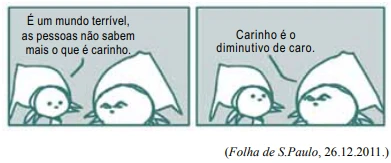
Na oração do 4.º parágrafo – [...] para que lhe seja - UNIFESP 2013
Língua Portuguesa - 2013O silêncio é a matéria significante por excelência, um continuum significante. O real da comunicação é o silêncio. E como o nosso objeto de reflexão é o discurso, chegamos a uma outra afirmação que sucede a essa: o silêncio é o real do discurso.
O homem está “condenado” a significar. Com ou sem palavras, diante do mundo, há uma injunção à “interpretação”: tudo tem de fazer sentido (qualquer que ele seja). O homem está irremediavelmente constituído pela sua relação com o simbólico.
Numa certa perspectiva, a dominante nos estudos dos signos, se produz uma sobreposição entre linguagem (verbal e não-verbal) e significação.
Disso decorreu um recobrimento dessas duas noções, resultando uma redução pela qual qualquer matéria significante fala, isto é, é remetida à linguagem (sobretudo verbal) para que lhe seja atribuído sentido. Nessa mesma direção, coloca-se o “império do verbal” em nossas formas sociais: traduz-se o silêncio em palavras. Vê-se assim o silêncio como linguagem e perde-se sua especificidade, enquanto matéria significan te distinta da linguagem.
(Eni Orlandi. As formas do silêncio, 1997.)
Ao analisar a prevalência da linguagem verbal na - UNIFESP 2013
Língua Portuguesa - 2013O silêncio é a matéria significante por excelência, um continuum significante. O real da comunicação é o silêncio. E como o nosso objeto de reflexão é o discurso, chegamos a uma outra afirmação que sucede a essa: o silêncio é o real do discurso.
O homem está “condenado” a significar. Com ou sem palavras, diante do mundo, há uma injunção à “interpretação”: tudo tem de fazer sentido (qualquer que ele seja). O homem está irremediavelmente constituído pela sua relação com o simbólico.
Numa certa perspectiva, a dominante nos estudos dos signos, se produz uma sobreposição entre linguagem (verbal e não-verbal) e significação.
Disso decorreu um recobrimento dessas duas noções, resultando uma redução pela qual qualquer matéria significante fala, isto é, é remetida à linguagem (sobretudo verbal) para que lhe seja atribuído sentido. Nessa mesma direção, coloca-se o “império do verbal” em nossas formas sociais: traduz-se o silêncio em palavras. Vê-se assim o silêncio como linguagem e perde-se sua especificidade, enquanto matéria significan te distinta da linguagem.
(Eni Orlandi. As formas do silêncio, 1997.)
No segundo parágrafo do texto, empregam-se as aspas no - UNIFESP 2013
Língua Portuguesa - 2013O silêncio é a matéria significante por excelência, um continuum significante. O real da comunicação é o silêncio. E como o nosso objeto de reflexão é o discurso, chegamos a uma outra afirmação que sucede a essa: o silêncio é o real do discurso.
O homem está “condenado” a significar. Com ou sem palavras, diante do mundo, há uma injunção à “interpretação”: tudo tem de fazer sentido (qualquer que ele seja). O homem está irremediavelmente constituído pela sua relação com o simbólico.
Numa certa perspectiva, a dominante nos estudos dos signos, se produz uma sobreposição entre linguagem (verbal e não-verbal) e significação.
Disso decorreu um recobrimento dessas duas noções, resultando uma redução pela qual qualquer matéria significante fala, isto é, é remetida à linguagem (sobretudo verbal) para que lhe seja atribuído sentido. Nessa mesma direção, coloca-se o “império do verbal” em nossas formas sociais: traduz-se o silêncio em palavras. Vê-se assim o silêncio como linguagem e perde-se sua especificidade, enquanto matéria significan te distinta da linguagem.
(Eni Orlandi. As formas do silêncio, 1997.)
Nesses versos da última estrofe do poema, o sentido - UNIFESP 2013
Língua Portuguesa - 2013Há tantos diálogos
Diálogo com o ser amado
o semelhante
o diferente
o indiferente
o oposto
o adversário
o surdo-mudo
o possesso
o irracional
o vegetal
o mineral
o inominado
Diálogo consigo mesmo
com a noite
os astros
os mortos
as ideias
o sonho
o passado
o mais que futuro
Escolhe teu diálogo
e
tua melhor palavra
ou
teu melhor silêncio
Mesmo no silêncio e com o silêncio
dialogamos.
(Carlos Drummond de Andrade.
Discurso de primavera e algumas sombras, 1977.)
Na abordagem temática do poema, destaca-se a inserção - UNIFESP 2013
Língua Portuguesa - 2013Há tantos diálogos
Diálogo com o ser amado
o semelhante
o diferente
o indiferente
o oposto
o adversário
o surdo-mudo
o possesso
o irracional
o vegetal
o mineral
o inominado
Diálogo consigo mesmo
com a noite
os astros
os mortos
as ideias
o sonho
o passado
o mais que futuro
Escolhe teu diálogo
e
tua melhor palavra
ou
teu melhor silêncio
Mesmo no silêncio e com o silêncio
dialogamos.
(Carlos Drummond de Andrade.
Discurso de primavera e algumas sombras, 1977.)
O eu lírico, ao mostrar as variedades do diálogo - UNIFESP 2013
Língua Portuguesa - 2013Há tantos diálogos
Diálogo com o ser amado
o semelhante
o diferente
o indiferente
o oposto
o adversário
o surdo-mudo
o possesso
o irracional
o vegetal
o mineral
o inominado
Diálogo consigo mesmo
com a noite
os astros
os mortos
as ideias
o sonho
o passado
o mais que futuro
Escolhe teu diálogo
e
tua melhor palavra
ou
teu melhor silêncio
Mesmo no silêncio e com o silêncio
dialogamos.
(Carlos Drummond de Andrade.
Discurso de primavera e algumas sombras, 1977.)
Examine a tira Níquel Náusea, do cartunista Fernando - UNIFESP 2013
Língua Portuguesa - 2013Examine a tira Níquel Náusea, do cartunista Fernando Gonsales.

Observe a charge. Considerando o processo de urbanização - VUNESP 2013
Geografia - 2013Observe a charge.
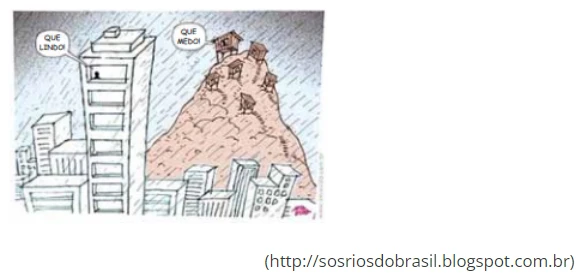
De suma importância na avaliação das condições de vida - VUNESP 2013
Geografia - 2013De suma importância na avaliação das condições de vida de uma sociedade, a taxa de mortalidade infantil refere-se ao número de crianças que morrem ao longo do primeiro ano de vida, durante determinado ano civil. Os gráficos mostram a evolução da taxa de mortalidade infantil no Brasil e apresentam uma comparação com taxas de outros países do mundo.
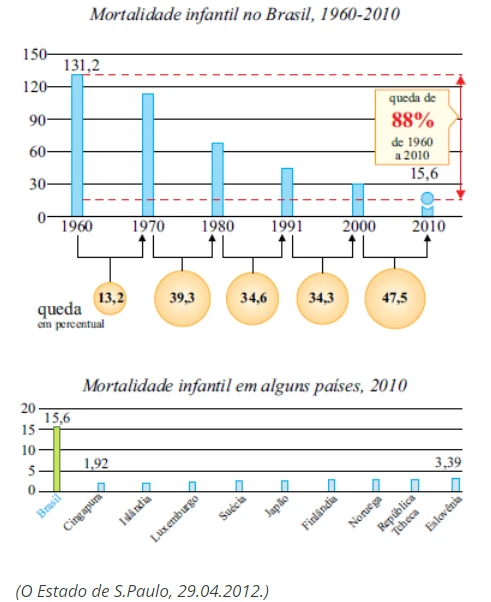
Analise o gráfico e a tabela. A partir da análise do - VUNESP 2013
Geografia - 2013Analise o gráfico e a tabela.
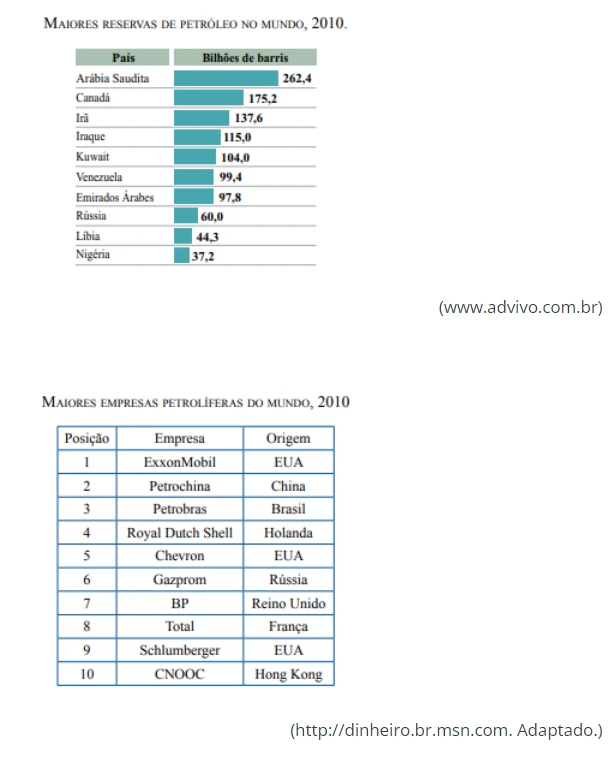
Leia a charge. A charge ironiza a velocidade na cobrança - VUNESP 2013
Língua Portuguesa - 2013Leia a charge.

As informações contidas nos quadrinhos permitem - VUNESP 2013
Língua Portuguesa - 2013
“Conjunto de, ao menos, 51 domicílios em área ocupada - VUNESP 2013
Geografia - 2013“Conjunto de, ao menos, 51 domicílios em área ocupada irregularmente e com precariedade de serviços públicos essenciais. São favelas, grotas, vilas e palafitas, entre outros”. Assim define o IBGE o termo “aglomerado subnormal”. Dados do Censo Demográfico de 2010 revelam que 11,4 milhões de brasileiros vivem em aglomerados precários.

O mapa mostra os estados do Nordeste brasileiro atingido - VUNESP 2013
Geografia - 2013O mapa mostra os estados do Nordeste brasileiro atingidos pela seca.
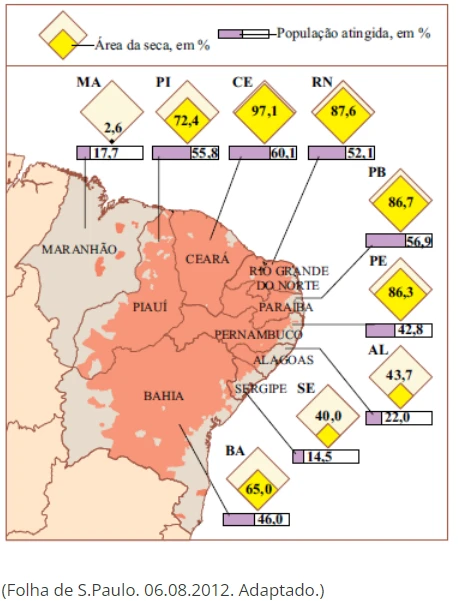
As florestas tropicais, as mais ricas em biodiversidade - VUNESP 2013
Geografia - 2013As florestas tropicais, as mais ricas em biodiversidade, estão entre os ecossistemas mais importantes do planeta. A Mata Atlântica, conforme se pode constatar na figura, sofreu uma redução brutal em termos de área ocupada.

Em relação aos dois parágrafos transcritos, o título do - VUNESP 2013
Língua Portuguesa - 2013
Sobre o comércio mundial de cocaína, é correto afirmar - VUNESP 2013
Geografia - 2013Analise o mapa.
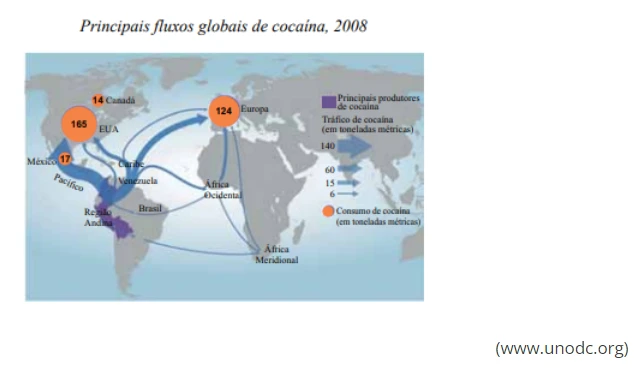
Considerando as zonas climáticas e os fatores que - VUNESP 2013
Geografia - 2013Examine o gráfico.
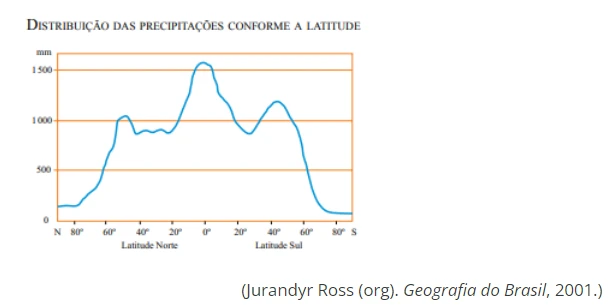
Na figura estão representadas as curvas pressão de vapor - VUNESP 2013
Química - 2013Na figura estão representadas as curvas pressão de vapor x temperatura para três solventes puros: benzeno (curva vermelha), água (curva azul) e ácido acético (curva verde).
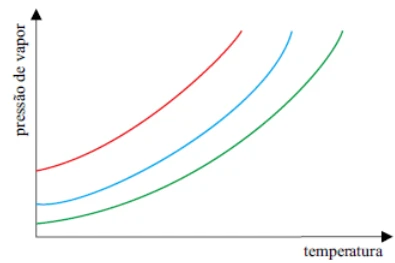
Na charge, para efeito de humor, faz-se um jogo de - VUNESP 2013
Língua Portuguesa - 2013
Alimento enriquecido é todo alimento ao qual foi - VUNESP 2013
Química - 2013Alimento enriquecido é todo alimento ao qual foi adicionada uma substância nutriente, com o objetivo de reforçar o seu valor nutritivo. A vitamina C, estrutura representada na figura, é uma das vitaminas utilizadas na suplementação de alimentos.

A vanilina, 4-hidroxi-3-metoxibenzaldeído, fórmula C8 - VUNESP 2013
Química - 2013A vanilina, 4-hidroxi-3-metoxibenzaldeído, fórmula C8 H8 O3 , é responsável pelo aroma e sabor de baunilha, muito apreciados no mundo inteiro. É obtida tradicionalmente das vagens, também chamadas de favas, de uma orquídea tropical, a Vanilla planifolia.
A figura mostra um processo de extração da vanilina a partir de vagens de orquídea espalhadas sobre bandejas perfuradas, em tanques de aço, usando etanol (60% v/v) como solvente. Em geral, a extração dura duas semanas.

Para o geógrafo Aziz Nacib Ab’Sáber, o domínio - VUNESP 2013
Geografia - 2013Para o geógrafo Aziz Nacib Ab’Sáber, o domínio morfoclimático e fitogeográfico pode ser entendido como um conjunto espacial extenso, com coerente grupo de feições do relevo, tipos de solo, formas de vegetação e condições climático-hidrológicas.
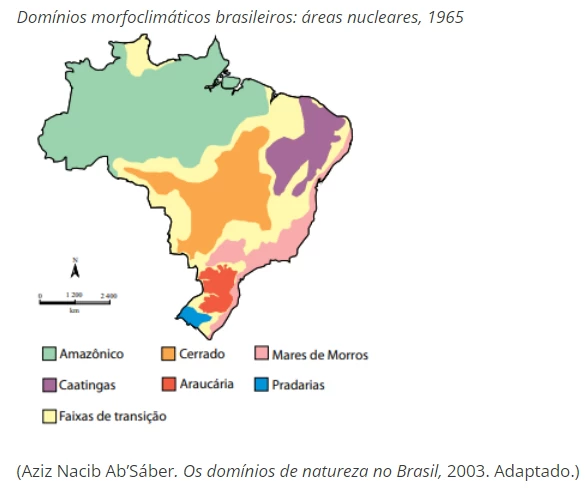
Os chamados “desastres naturais” podem ter causas - VUNESP 2013
Geografia - 2013
Com relação à disseminação dos serviços de saneamento - VUNESP 2013
Geografia - 2013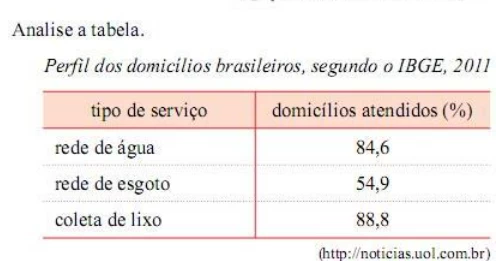
Na planície avermelhada os juazeiros alargavam duas - VUNESP 2013
Geografia - 2013Na planície avermelhada os juazeiros alargavam duas manchas verdes. Os infelizes tinham caminhado o dia inteiro, estavam cansados e famintos. Ordinariamente andavam pouco, mas como haviam repousado bastante na areia do rio seco, a viagem progredira bem três léguas. Fazia horas que procuravam uma sombra. A folhagem dos juazeiros apareceu longe, através dos galhos pelados [...].
A atual política do governo brasileiro de apoio à - VUNESP 2013
Geografia - 2013A atual política do governo brasileiro de apoio à produção de biocombustíveis traz consigo alguns objetivos e produz consequências específicas, entre os quais podemos mencionar,
A natureza é reavaliada e valorizada como informação - VUNESP 2013
Geografia - 2013A natureza é reavaliada e valorizada como informação sobre a vida e os recursos potenciais, de modo que a valorização dos elementos é condicionada por novas tecnologias. É o caso da natureza como fonte de informação para a biotecnologia, com base na decodificação, leitura e instrumentalização da biodiversidade. Em outras palavras, a natu reza é valorizada como capital de realização atual ou futura e como fonte de poder para a ciência contemporânea. No entan to, os estoques de natureza estão localizados em territórios de Estados ou em espaços ainda não regulamentados juridicamente, e a apropriação da decisão sobre o uso de territórios e ambientes como reservas de valor, isto é, sem uso produtivo imediato, torna-se uma forma de controlar o capital natural para o uso futuro. Constitui-se assim um novo componente na disputa entre as potências – detentoras da tecnologia – pelo controle dos estoques de natureza, localizados, sobretudo, nos países periféricos e em espaços não apropriados.
Há o mito de que o Brasil é, e continuará a ser, um país - VUNESP 2013
Geografia - 2013Há o mito de que o Brasil é, e continuará a ser, um país com uma população predominantemente jovem, muito diferente daquela dos países europeus, onde sobressaem os mais idosos. Também nesse caso há evidências que colaboram com o ima- ginário, pois, de fato, a estrutura etária da população do país ainda está muito distante da realidade demográfica do Velho Mundo. Entretanto, as mudanças ocorridas na segunda metade do século XX foram tão rápidas que o Brasil ficou mais próximo dos países europeus do que geralmente se imagina.
São organizações que têm como objetivo, entre outros, a - VUNESP 2013
Geografia - 2013São organizações que têm como objetivo, entre outros, a coope- ração entre os povos e a regulamentação do comércio mundial,
Líderes mundiais, juntamente com milhares de - VUNESP 2013
Geografia - 2013Líderes mundiais, juntamente com milhares de participantes do setor privado, ONGs e outras organizações, trabalharão em conjunto para formular soluções que possam ajudar a reduzir a pobreza, promover maior igualdade social e assegurar a segurança ambiental para um planeta que experimenta um tremendo crescimento populacional. É uma oportunidade histórica para definirmos os caminhos para um futuro sustentável, com mais emprego, mais fontes de energia limpa, mais segurança e um padrão de vida decente para todos
A vegetação nativa do Parque Estadual de Vila Velha, no - VUNESP 2013
Biologia - 2013A vegetação nativa do Parque Estadual de Vila Velha, no Paraná, vem enfrentando graves problemas, devido à infestação de árvores de Pinus. A fácil adaptação do Pinus às condições ambientais desse parque tem feito com que as espécies típicas dos campos, cerrado e florestas de araucária encontrem dificuldades em seu desenvolvimento, com grandes riscos de extinção, especialmente devido ao sombreamento e à formação de densa serrapilheira. O Pinus é considerado uma espécie ___________ e uma solução para esse problema é a sua _________.
Os agrotóxicos são compostos sintéticos usados no - VUNESP 2013
Biologia - 2013Os agrotóxicos são compostos sintéticos usados no combate a pragas em plantações. No entanto, estima-se que somente 0,1% do agrotóxico aplicado se mantém no alvo, enquanto que o restante é dispersado no ambiente. A figura a seguir é uma representação esquemática dos processos determinantes do comportamento e do destino dos agrotóxicos.
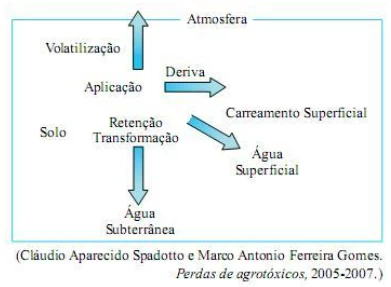
Faz um mês que Lucas deixou de usar sedativos. Ao - VUNESP 2013
Biologia - 2013Faz um mês que Lucas deixou de usar sedativos. Ao nascer, o franzino bebê, agora com quatro meses, era agitado, chorava muito, sofria tremores e taquicardia, sintomas da abstinência. Lucas é filho de uma usuária de crack e “consumiu” a droga durante os sete meses de vida uterina. Nasceu prematuro, com apenas 1,8 kg. A operação policial iniciada em 3 de janeiro jogou luz sobre as dezenas de grávidas dependentes que perambulam pelo cen- tro paulistano atrás da droga.
A figura mostra uma antiga área de cultivo em processo - VUNESP 2013
Biologia - 2013A figura mostra uma antiga área de cultivo em processo de recuperação ambiental.
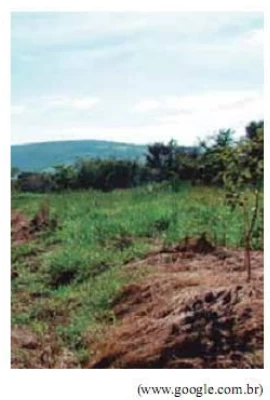
Já os gráficos representam alterações que ocorrem nessa área durante o processo de recuperação.
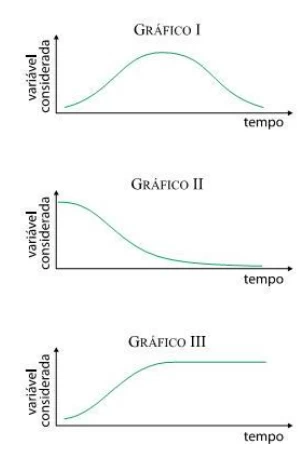
A ema (Rhea americana), o avestruz (Struthio camelus) e - VUNESP 2013
Biologia - 2013A ema (Rhea americana), o avestruz (Struthio camelus) e o emu (Dromaius novaehollandiae) são aves que não voam e que compartilham entre si um ancestral comum mais recente que aquele que compartilham com outros grupos de aves. Essas três espécies ocupam hábitats semelhantes, contudo apresentam área de distribuição bastante distinta. A ema ocorre no sul da América do Sul, o avestruz é africano e o emu ocorre na Austrália
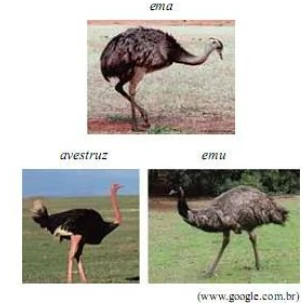
Alguns chefs de cozinha sugerem que o peru não deve ser - VUNESP 2013
Biologia - 2013Alguns chefs de cozinha sugerem que o peru não deve ser preparado inteiro, pois a carne do peito e a da coxa têm características diferentes, que exigem preparos diferentes. A carne do peito é branca e macia, e pode ressecar dependendo do modo como é preparada. A carne da coxa, mais escura, é mais densa e suculenta e deve ser preparada separadamente.
A complexa organização social das formigas pode ser - VUNESP 2013
Biologia - 2013A complexa organização social das formigas pode ser explicada pelas relações de parentesco genético entre os indivíduos da colônia. É geneticamente mais vantajoso para as operárias cuidarem das suas irmãs que terem seus próprios filhos e filhas.
No formigueiro, uma única fêmea, a rainha, que é diploide, põe ovos que, quando fertilizados, se desenvolvem em operárias também diploides. Os ovos não fertilizados dão origem aos machos da colônia. Esses machos, chamados de bitus, irão fertilizar novas rainhas para a formação de novos formigueiros. Como esses machos são haploides, transmitem integralmente para suas filhas seu material genético. As rainhas transmitem para suas filhas e filhos apenas metade de seu material genético.
No dia 16 de fevereiro de 2013 terminou o horário brasil - VUNESP 2013
Biologia - 2013No dia 16 de fevereiro de 2013 terminou o horário brasileiro de verão. À meia-noite, os relógios foram atrasados em uma hora.

Três consumidores, A, B e C, compraram, cada um deles, - VUNESP 2013
Biologia - 2013Três consumidores, A, B e C, compraram, cada um deles,uma bebida em embalagem longa vida, adequada às suas respectivas dietas. As tabelas abaixo trazem informações nutricionais sobre cada uma dessas três bebidas.

A figura mostra o encontro de duas células, um espermato - VUNESP 2013
Biologia - 2013A figura mostra o encontro de duas células, um espermatozoide e um ovócito humano, momentos antes da fecundação.

Porém, o ilustrador cometeu um engano ao identificar as - VUNESP 2013
Biologia - 2013
São processos que vêm contribuindo para o acirramento da - VUNESP 2013
Geografia - 2013São processos que vêm contribuindo para o acirramento da tensão social envolvendo
As imagens apresentam, em momentos históricos distintos, - VUNESP 2013
Geografia - 2013As imagens apresentam, em momentos históricos distintos, uma das paisagens mais conhecidas do Brasil: a praia de Copacabana, no Rio de Janeiro. A partir da análise das pai- sagens, pode-se notar o intenso processo de adensamento e verticalização das edificações ocorrido na região ao longo do último século.
Considerando conhecimentos sobre a situação atual de - VUNESP 2013
Geografia - 2013Considerando conhecimentos sobre a situação atual de uso, ocupação demográfica, disponibilidade hídrica e degradação das bacias hidrográficas brasileiras,
Ao se espalharem pelo território brasileiro, esses - VUNESP 2013
Geografia - 2013Ao se espalharem pelo território brasileiro, esses protestos evidenciaram características do espaço geográfico próprias do atual período histórico da globalização.
Os protestos que tomaram as ruas do Brasil durante o mês - VUNESP 2013
Geografia - 2013Os protestos que tomaram as ruas do Brasil durante o mês de junho de 2013 foram originalmente motivados por problema que aflige grande parte da população que vive nas grandes cidades do país,
Após os atentados de 11 de setembro de 2001, o governo - VUNESP 2013
Geografia - 2013Após os atentados de 11 de setembro de 2001, o governo dos Estados Unidos da América aprovou uma série de medidas com o objetivo de proteger os cidadãos americanos da ameaça representada pelo terrorismo internacional.
A tensão observada entre a Coreia do Norte e a Coreia do - VUNESP 2013
Geografia - 2013A tensão observada entre a Coreia do Norte e a Coreia do Sul
No texto, em resposta à pergunta “Does he see himself as - FUVEST 2013
Inglês - 2013Missing Out: In Praise of the Unlived Life is Adam Phillips's 17th book and is a characteristic blend of literary criticism and philosophical reflection packaged around a central idea. The theme here is missed opportunities, roads not taken, alternative versions of our lives and ourselves, all of which, Phillips argues, exert a powerful hold over our imaginations. Using a series of examples and close readings of authors including Philip Larkin and Shakespeare, the book suggests that a broader understanding of life's inevitable disappointments and thwarted desires can enable us to live fuller, richer lives. Good things come to those who wait. Does he see himself as a champion of frustration? “I'm not on the side of frustration exactly, so much as the idea that one has to be able to bear frustration in order for satisfaction to be realistic. I'm interested in how the culture of consumer capitalism depends on the idea that we can't bear frustration, so that every time we feel a bit restless or bored or irritable, we eat, or we shop.”
Segundo o texto, o livro Missing Out: In Praise of the - FUVEST 2013
Inglês - 2013Missing Out: In Praise of the Unlived Life is Adam Phillips's 17th book and is a characteristic blend of literary criticism and philosophical reflection packaged around a central idea. The theme here is missed opportunities, roads not taken, alternative versions of our lives and ourselves, all of which, Phillips argues, exert a powerful hold over our imaginations. Using a series of examples and close readings of authors including Philip Larkin and Shakespeare, the book suggests that a broader understanding of life's inevitable disappointments and thwarted desires can enable us to live fuller, richer lives. Good things come to those who wait. Does he see himself as a champion of frustration? “I'm not on the side of frustration exactly, so much as the idea that one has to be able to bear frustration in order for satisfaction to be realistic. I'm interested in how the culture of consumer capitalism depends on the idea that we can't bear frustration, so that every time we feel a bit restless or bored or irritable, we eat, or we shop.” theguardian
Afirma-se, no texto, que, diferentemente da TV, na - FUVEST 2013
Inglês - 2013
Time was, advertising was a relatively simple undertaking: buy some print space and airtime, create the spots, and blast them at a captive audience. Today it’s chaos: while passive viewers still exist, mostly we pick and choose what to consume, ignoring ads with a touch of the DVR remote. Ads are forced to become more like content, and the best aim to engage consumers so much that they pass the material on to friends – by email, Twitter, Facebook – who will pass it on to friends, who will… you get the picture. In the industry, “viral” has become a usefully vague way to describe any campaign that spreads from person to person, acquiring its own momentum.
It’s not that online advertising has eclipsed TV, but it has become its full partner – and in many ways the more substantive one, a medium in which the audience must be earned, not simply bought.
No texto, a palavra “viral” refere-se a campanhas - FUVEST 2013
Inglês - 2013
Time was, advertising was a relatively simple undertaking: buy some print space and airtime, create the spots, and blast them at a captive audience. Today it’s chaos: while passive viewers still exist, mostly we pick and choose what to consume, ignoring ads with a touch of the DVR remote. Ads are forced to become more like content, and the best aim to engage consumers so much that they pass the material on to friends – by email, Twitter, Facebook – who will pass it on to friends, who will… you get the picture. In the industry, “viral” has become a usefully vague way to describe any campaign that spreads from person to person, acquiring its own momentum.
It’s not that online advertising has eclipsed TV, but it has become its full partner – and in many ways the more substantive one, a medium in which the audience must be earned, not simply bought.
De acordo com o texto, a indústria publicitária passou - FUVEST 2013
Inglês - 2013
Time was, advertising was a relatively simple undertaking: buy some print space and airtime, create the spots, and blast them at a captive audience. Today it’s chaos: while passive viewers still exist, mostly we pick and choose what to consume, ignoring ads with a touch of the DVR remote. Ads are forced to become more like content, and the best aim to engage consumers so much that they pass the material on to friends – by email, Twitter, Facebook – who will pass it on to friends, who will… you get the picture. In the industry, “viral” has become a usefully vague way to describe any campaign that spreads from person to person, acquiring its own momentum.
It’s not that online advertising has eclipsed TV, but it has become its full partner – and in many ways the more substantive one, a medium in which the audience must be earned, not simply bought.
Guardadas as diferenças que separam as obras a seguir - FUVEST 2013
Literatura - 2013Morro da Babilônia
À noite, do morro
descem vozes que criam o terror
(terror urbano, cinquenta por cento de cinema,
e o resto que veio de Luanda ou se perdeu na língua
[geral).
Quando houve revolução, os soldados se espalharam
[no morro,
o quartel pegou fogo, eles não voltaram.
Alguns, chumbados, morreram.
O morro ficou mais encantado.
Mas as vozes do morro
não são propriamente lúgubres.
Há mesmo um cavaquinho bem afinado
que domina os ruídos da pedra e da folhagem
e desce até nós, modesto e recreativo,
como uma gentileza do morro.
Leia as seguintes afirmações sobre o poema de Drummond, - FUVEST 2013
Literatura - 2013Morro da Babilônia
À noite, do morro
descem vozes que criam o terror
(terror urbano, cinquenta por cento de cinema,
e o resto que veio de Luanda ou se perdeu na língua
[geral).
Quando houve revolução, os soldados se espalharam
[no morro,
o quartel pegou fogo, eles não voltaram.
Alguns, chumbados, morreram.
O morro ficou mais encantado.
Mas as vozes do morro
não são propriamente lúgubres.
Há mesmo um cavaquinho bem afinado
que domina os ruídos da pedra e da folhagem
e desce até nós, modesto e recreativo,
como uma gentileza do morro.
Leia as seguintes afirmações sobre o poema de Drummond, considerado no contexto do livro a que pertence:
I. No conjunto formado pelos poemas do livro, a referência ao Morro da Babilônia – feita no título do texto – mais as menções ao Leblon e ao Méier, a Copacabana, a São Cristóvão e ao Mangue, – presentes em outros poemas –, sendo todas, ao mesmo tempo, espaciais e de classe, constituem uma espécie de discreta topografia social do Rio de Janeiro.
II. Nesse poema, assim como ocorre em outros textos do livro, a atenção à vida presente abre-se também para a dimensão do passado, seja ele dado no registro da história ou da memória.
III. A menção ao “cavaquinho bem afinado”, ao cabo do poema, revela ter sido nesse livro que o poeta finalmente assumiu as canções da música popular brasileira como o modelo definitivo de sua lírica, superando, assim, seu antigo vínculo com a poesia de matriz culta ou erudita.
Os momentos históricos em que se desenvolvem os enredos - FUVEST 2013
Literatura - 2013Os momentos históricos em que se desenvolvem os enredos de Viagens na minha terra, Memórias de um sargento de milícias e Memórias póstumas de Brás Cubas (quanto a este último, em particular no que se refere à primeira juventude do narrador) são, todos, determinados de modo decisivo por um antecedente histórico comum – menos ou mais imediato, conforme o caso. Trata-se da
Em quatro das alternativas abaixo, registram-se alguns - FUVEST 2013
Literatura - 2013Em quatro das alternativas abaixo, registram-se alguns dos aspectos que, para bem caracterizar o gênero e o estilo das Memórias póstumas de Brás Cubas, o crítico J. G. Merquior pôs em relevo nessa obra de Machado de Assis. A única alternativa que, invertendo, aliás, o juízo do mencionado crítico, aponta uma característica que NÃO se aplica à obra em questão é:
Leia o seguinte texto. O autor pensava estar romanceando - FUVEST 2013
Literatura - 2013Leia o seguinte texto.
O autor pensava estar romanceando o processo brasileiro de guerra e acomodação entre as raças, em conformidade com as teorias racistas da época, mas, na verdade, conduzido pela lógica da ficção, mostrava um processo primitivo de exploração econômica e formação de classes, que se encaminhava de um modo passavelmente bárbaro e desmentia as ilusões do romancista.
As expressões “ares aristocráticos” e “descamisados” - FUVEST 2013
Língua Portuguesa - 2013Ata
Acredito que o mau tempo haja concorrido para que os sabadoyleanos* hoje não estivessem na casa de José Mindlin, em São Paulo, gozando das delícias do cuscuz paulista aqui amavelmente prometido. Depois do almoço, visita aos livros dialogantes, na expressão de Drummond, não sabemos se no rigoroso sistema de vigilância de Plínio Doyle, mas de qualquer forma com as gentilezas das reuniões cariocas. Para o amigo de São Paulo as saudações afetuosas dos ausentespresentes, que neste instante todos nos voltamos para o seu palácio, aquele que se iria desvestir dos ares aristocráticos para receber camaradescamente os descamisados da Rua Barão de Jaguaribe.
Guarde, amigo Mindlin, para breve o cuscuz da tradição bandeirante, que hoje nos conformamos com os biscoitos à la Plínio Doyle.
(Rio, 20-11-1976.)
Signatários: Carlos Drummond de Andrade, Gilberto de Mendonça Teles, Plínio Doyle e outros.
(Cartas da biblioteca Guita e José Mindlin. Adaptado.)
* “sabadoyleanos”: frequentadores do sabadoyle, nome dado ao encontro de intelectuais, especialmente escritores, realizado habitualmente aos sábados, na casa do bibliófilo Plínio Doyle, situada no Rio de Janeiro.
Da leitura do texto, depreende-se que o anfitrião - FUVEST 2013
Língua Portuguesa - 2013Ata
Acredito que o mau tempo haja concorrido para que os sabadoyleanos* hoje não estivessem na casa de José Mindlin, em São Paulo, gozando das delícias do cuscuz paulista aqui amavelmente prometido. Depois do almoço, visita aos livros dialogantes, na expressão de Drummond, não sabemos se no rigoroso sistema de vigilância de Plínio Doyle, mas de qualquer forma com as gentilezas das reuniões cariocas. Para o amigo de São Paulo as saudações afetuosas dos ausentespresentes, que neste instante todos nos voltamos para o seu palácio, aquele que se iria desvestir dos ares aristocráticos para receber camaradescamente os descamisados da Rua Barão de Jaguaribe.
Guarde, amigo Mindlin, para breve o cuscuz da tradição bandeirante, que hoje nos conformamos com os biscoitos à la Plínio Doyle.
(Rio, 20-11-1976.)
Signatários: Carlos Drummond de Andrade, Gilberto de Mendonça Teles, Plínio Doyle e outros.
(Cartas da biblioteca Guita e José Mindlin. Adaptado.)
* “sabadoyleanos”: frequentadores do sabadoyle, nome dado ao encontro de intelectuais, especialmente escritores, realizado habitualmente aos sábados, na casa do bibliófilo Plínio Doyle, situada no Rio de Janeiro.
Em Viagens na minha terra, assim como em a) Memórias de - FUVEST 2013
Língua Portuguesa - 2013Em Viagens na minha terra, assim como em
Considerada no contexto histórico a que se refere Til, - FUVEST 2013
Língua Portuguesa - 2013V – O samba
À direita do terreiro, adumbra-se* na escuridão um maciço de construções, ao qual às vezes recortam no azul do céu os trêmulos vislumbres das labaredas fustigadas pelo vento.
(...)
É aí o quartel ou quadrado da fazenda, nome que tem um grande pátio cercado de senzalas, às vezes com alpendrada corrida em volta, e um ou dois portões que o fecham como praça d’armas.
Em torno da fogueira, já esbarrondada pelo chão, que ela cobriu de brasido e cinzas, dançam os pretos o samba com um frenesi que toca o delírio. Não se descreve, nem se imagina esse desesperado saracoteio, no qual todo o corpo estremece, pula, sacode, gira, bamboleia, como se quisesse desgrudar-se.
Tudo salta, até os crioulinhos que esperneiam no cangote das mães, ou se enrolam nas saias das raparigas. Os mais taludos viram cambalhotas e pincham à guisa de sapos em roda do terreiro. Um desses corta jaca no espinhaço do pai, negro fornido, que não sabendo mais como desconjuntar-se, atirou consigo ao chão e começou de rabanar como um peixe em seco. (...)
(*) “adumbra-se” = delineia-se, esboça-se.
Ao comentar o romance Til e, inclusive, a cena do - FUVEST 2013
Língua Portuguesa - 2013V – O samba
À direita do terreiro, adumbra-se* na escuridão um maciço de construções, ao qual às vezes recortam no azul do céu os trêmulos vislumbres das labaredas fustigadas pelo vento.
(...)
É aí o quartel ou quadrado da fazenda, nome que tem um grande pátio cercado de senzalas, às vezes com alpendrada corrida em volta, e um ou dois portões que o fecham como praça d’armas.
Em torno da fogueira, já esbarrondada pelo chão, que ela cobriu de brasido e cinzas, dançam os pretos o samba com um frenesi que toca o delírio. Não se descreve, nem se imagina esse desesperado saracoteio, no qual todo o corpo estremece, pula, sacode, gira, bamboleia, como se quisesse desgrudar-se.
Tudo salta, até os crioulinhos que esperneiam no cangote das mães, ou se enrolam nas saias das raparigas. Os mais taludos viram cambalhotas e pincham à guisa de sapos em roda do terreiro. Um desses corta jaca no espinhaço do pai, negro fornido, que não sabendo mais como desconjuntar-se, atirou consigo ao chão e começou de rabanar como um peixe em seco. (...)
(*) “adumbra-se” = delineia-se, esboça-se.
Na composição do texto, foram usados, reiteradamente, - FUVEST 2013
Língua Portuguesa - 2013V – O samba
À direita do terreiro, adumbra-se* na escuridão um maciço de construções, ao qual às vezes recortam no azul do céu os trêmulos vislumbres das labaredas fustigadas pelo vento.
(...)
É aí o quartel ou quadrado da fazenda, nome que tem um grande pátio cercado de senzalas, às vezes com alpendrada corrida em volta, e um ou dois portões que o fecham como praça d’armas.
Em torno da fogueira, já esbarrondada pelo chão, que ela cobriu de brasido e cinzas, dançam os pretos o samba com um frenesi que toca o delírio. Não se descreve, nem se imagina esse desesperado saracoteio, no qual todo o corpo estremece, pula, sacode, gira, bamboleia, como se quisesse desgrudar-se.
Tudo salta, até os crioulinhos que esperneiam no cangote das mães, ou se enrolam nas saias das raparigas. Os mais taludos viram cambalhotas e pincham à guisa de sapos em roda do terreiro. Um desses corta jaca no espinhaço do pai, negro fornido, que não sabendo mais como desconjuntar-se, atirou consigo ao chão e começou de rabanar como um peixe em seco. (...)
(*) “adumbra-se” = delineia-se, esboça-se.
Na composição do texto, foram usados, reiteradamente,
I. sujeitos pospostos;
II. termos que intensificam a ideia de movimento;
III. verbos no presente histórico.
Para adequar a linguagem ao assunto, o autor lança mão - FUVEST 2013
Língua Portuguesa - 2013V – O samba
À direita do terreiro, adumbra-se* na escuridão um maciço de construções, ao qual às vezes recortam no azul do céu os trêmulos vislumbres das labaredas fustigadas pelo vento.
(...)
É aí o quartel ou quadrado da fazenda, nome que tem um grande pátio cercado de senzalas, às vezes com alpendrada corrida em volta, e um ou dois portões que o fecham como praça d’armas.
Em torno da fogueira, já esbarrondada pelo chão, que ela cobriu de brasido e cinzas, dançam os pretos o samba com um frenesi que toca o delírio. Não se descreve, nem se imagina esse desesperado saracoteio, no qual todo o corpo estremece, pula, sacode, gira, bamboleia, como se quisesse desgrudar-se.
Tudo salta, até os crioulinhos que esperneiam no cangote das mães, ou se enrolam nas saias das raparigas. Os mais taludos viram cambalhotas e pincham à guisa de sapos em roda do terreiro. Um desses corta jaca no espinhaço do pai, negro fornido, que não sabendo mais como desconjuntar-se, atirou consigo ao chão e começou de rabanar como um peixe em seco. (...)
(*) “adumbra-se” = delineia-se, esboça-se.
Apoie nosso trabalho!
Assine Agora